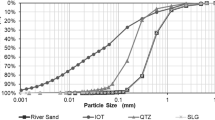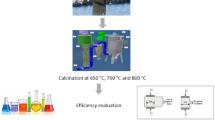Abstract
To successfully transition any economy towards sustainable development requires reducing the consumption of raw materials while maintaining production levels. In the French construction sector, nearly 55% of extracted materials are aggregates. A potential solution to decreasing the carbon footprint of the construction sector and reducing the consumption of raw materials consists in recovering industrial byproducts, in particular reclaiming dredged sediments for use as a mineral component in mortar formulas. However, these sediments require adequate and optimal pretreatment to be implemented effectively. Several processing techniques have thus far been applied to improve specific physicochemical properties. Heat treatment through calcination has proven effective in removing organic matter and activating the pozzolanic properties of the sediments. The present study demonstrates that optimizing the heat treatment of marine sediment additives affects the physicomechanical and environmental properties of mortar. Compared with a standard reference mortar, substituting an optimum portion of cement with sediments that were calcination-treated at 750 °C achieved at least identical and even improved mechanical properties of the cement matrix. Incorporating up to 20% of calcined sediment as a cement substitute did not affect the durability of the mortar. In fact, a cement substitution of 10% improved the accelerated carbonation behavior. The characteristics of these mortar formulas were evaluated from an environmental and life cycle point of view and compared with inert waste reference thresholds (in accordance with the French inert waste storage facilities directive of 2010).









Similar content being viewed by others
References
Agence de l’eau Artois-Picardie, Methode de gestion et de réutilisation des sédiments pollués, p. 1–126, 2000
Dubois V, Abriak NE, Zentar R, Ballivy G (2009) The use of marine sediments as a pavement base material. Waste Manag 29(2):774–782
Zentar R, Dubois V, Abriak NE (2008) Mechanical behaviour and environmental impacts of a test road built with marine dredged sediments. Resour Conserv Recycl 52(6):947–954
Cappuyns V, Deweirt V, Rousseau S (2015) Dredged sediments as a resource for brick production: possibilities and barriers from a consumers’ perspective. Waste Manag 38:372–380
Achour R (2013) Valorisation et Caractérisation de la Durabilité d’un Matériau Routier et d’un Béton à Base de Sédiments de Dragage
Oh H, Lee J, Banthia N, Talukdar S (2011) An experimental study of the physicochemical properties of a cement matrix containing dredged materials. Mater Sci Appl 02(07):847–857
Dalton JL, Gardner KH, Seager TP, Weimer ML, Spear JC, Magee BJ (2004) Properties of Portland cement made from contaminated sediments. Resour Conserv Recycl 41(3):227–241
Samara M, Lafhaj Z, Chapiseau C (2009) Valorization of stabilized river sediments in fired clay bricks: factory scale experiment. J Hazard Mater 163(2):701–710
El Fgaier F, Lafhaj Z, Chapiseau C (2013) Use of clay bricks incorporating treated river sediments in a demonstrative building: Case study. Constr Build Mater 48:160–165
Said I, Missaoui A, Lafhaj Z (2015) Reuse of Tunisian marine sediments in paving blocks: factory scale experiment. J Cleaner Product 102:66–77
Rozière E, Samara M, Loukili A, Damidot D (2015) Valorisation of sediments in self-consolidating concrete: mix-design and microstructure. Constr Build Mater 81:1–10
Miraoui M, Zentar R, Abriak NE (2012) Road material basis in dredged sediment and basic oxygen furnace steel slag. Constr Build Mater 30:309–319
Belas N, Aggoun S, Benaissa A, Kheirbek A (2011) Valorisation des déchets naturels dans l’élaboration des nouveaux bétons et matériaux de construction. Abstract, pp 1–6
Limeira J, Etxeberria M, Agulló L, Molina D (2011) Mechanical and durability properties of concrete made with dredged marine sand. Constr Build Mater 25(11):4165–4174
San Nicolas R (2011) Approche performantielle des bétons avec métakaolins obtenus par calcination flash. Dissertation, University of Toulouse III-Paul Sabatier, France
Rodríguez O, Kacimi L, López-Delgado A, Frías M, Guerrero A (2013) Characterization of Algerian reservoir sludges for use as active additions in cement: new pozzolans for eco-cement manufacture. Constr Build Mater 40:275–279
Roux L, Unikowski Z (1980) Mise en évidence de l’ influence des fines argileuses dans les granulats à béton, pp 101–108
Dubois V (2006) Etude du comportement physico-mécanique et caractérisation environnementale des sédiments marins—Valorisation en technique routière, dissertation, University of ARTOIS, France
Tran NT (2009) Valorisation de sédiments marins et fluviaux en technique routière. Dissertation, Ecole Mines de Douai, France
Dang TA, Kamali-Bernard S, Prince WA (2013) Design of new blended cement based on arine dredged sediment. Constr Build Mater 41:602–611
Salvador S, Pons O (2000) Semi-mobile flash dryer/calciner unit to manufacture pozzolana from raw clay soils—application to soil stabilisation. Constr Build Mater 14(2):109–117
Anger B, Moulin I, Perin E, Thery F, Levacher D (2014) Utilisation de sédiments fins de barrage dans la fabrication de mortiers. XIIIèmes JNGCGC, Dunkerque, pp 953–960
Benkaddour M, Kazi Aoual F, Semcha A (2009) Durabilité des mortiers à base de pouzzolane naturelle et de pouzzolane artificielle. Rev Nat Tecnol 1:63–73
Cabane N (2004) Sols traités à la chaux et aux liants hydrauliques: Contribution à l’identification et à l’analyse des éléments perturbateurs de la stabilisation
Gastaldini ALG, Hengen MF, Gastaldini MCC, do Amaral FD, Antolini MB, Coletto T (2015) The use of water treatment plant sludge ash as a mineral addition. Constr Build Mater 94:513–520
Bouamrane A, Elouazzani DC, Barna LT, Mansouri K (2014) Valorisation des boues de papeterie comme matières premières secondaires dans les mortiers de ciment. Portland J Mater Environ Sci 5(2):605–614
Tironi A, Trezza MA, Scian AN, Irassar EF (2013) Assessment of pozzolanic activity of different calcined clays. Cem Concr Compos 37:319–327
Bolomey J (1935) Granulation et prévision de la résistance probable des bétons. Travaux 19(30):228–232
Mazars J (1984) Application de la mécanique de l’endommagement au comportement non linéaire et à la rupture du béton de structure
Maso JC (1996) Influence of the interfacial transition zone on composite mechanical properties. RILEM Rep 11:103–116
Park C-K (2000) Hydration and solidification of hazardous wastes containing heavy metals using modified cementitious materials. Cem Concr Res 30(3):429–435
Minocha AK, Neeraj J, Verma CL (2003) Effect of organic materials on the solidification of heavy sludge. Constr Build Mater 17:77–81
Yousuf M, Mollah A, Vempati RK, Lin T-C, Cocke DL (1995) The interfacial chemistry of solidification/stabilization of metals in cement and pozzolanic material systems. Waste Manag 15(2):137–148
Cyr M, Lawrence P, Ringot E (2005) Mineral admixtures in mortars. Cem Concr Res 35(4):719–730
Kim YH, Bae B, Choung YK (2005) Optimization of biological phosphorus removal from contaminated sediments with phosphate-solubilizing microorganisms. J Biosci Bioeng 99(1):23–29
Mulligan CN, Yong RN, Gibbs BF (2001) Remediation technologies for metal-contaminated soils and groundwater: an evaluation. Eng Geol 60(1):193–207
Lin J, Zhong Y, Fan H (2017) Chemical treatment of contaminated sediment for phosphorus control and subsequent effects on ammonia-oxidizing and ammonia-denitrifying microorganisms and on submerged macrophyte revegetation. Environ Sci Pollut Res 24(1):1007–1018
Okoli CP, Diagboya PN, Anigbogu IO et al (2017) Competitive biosorption of Pb(II) and Cd(II) ions from aqueous solutions using chemically modified moss biomass (Barbula lambarenensis). Environ Earth Sci 76(1):33
Illuri HK (2007) Development of soil-eps mixes for geotechnical applications. Queensland University of Technology, Australia
Song Y (2016) Traitement des sédiments de dragage: processus et couplages. Dissertation, University of Le Havre, France
Yoo J-C, Yang J-S, Jeon E-K et al (2015) Enhanced-electrokinetic extraction of heavy metals from dredged harbor sediment. Environ Sci Pollut Res 22(13):9912–9921
Agostini F, Skoczylas F, Lafhaj Z (2007) About a possible valorisation in cementitious materials of polluted sediments after treatment. Cem Concr Compos 29(4):270–278
Ramaroson J, Dia M, Dirion JL, Nzihou A, Depelsenaire G (2012) Thermal treatment of dredged sediment in a rotary kiln: Investigation of structural changes. Ind Eng Chem Res 51(21):7146–7152
Ramaroson J, Dia M, Dirion J-L, Nzihou A, Depelsenaire G (2012) Thermal treatment of dredged sediment in a rotary kiln: investigation of structural changes. Ind Eng Chem Res 51(21):7146–7152
Union Nationale des Industries de Carrières et Matériaux de construction and UNICEM (2015) Rapport et statistiques sur les granulats. Technical report
Millrath K, Kozlova S, Shimanovich S, Meyer C (2001) Beneficial use of dredge material. Technical report. Columbia University, New York, NY
Xu Y, Yan C, Xu B, Ruan X, Wei Z (2014) The use of urban river sediments as a primary raw material in the production of highly insulating brick. Ceram Int 40(6):8833–8840
Benslafa FKA, Kerdal D, Ameur M, Mekerta B, Semcha A (2015) Durability of mortars made with dredged sediments. Procedia Eng 118:240–250
Institute for Prospective Technological Studies Sustainable Production and Consumption Unit European IPPC Bureau (2013) Production of Cement, Lime and Magnesium Oxide. Eur Comm, Technical report
(EC) European Commission (2009) Report. Reference document on the best available techniques. Management of tailings and waste-rock in mining activities. Ref Doc Best Available Tech, January, 511
Rozière E, Samara M, Loukili A, Damidot D (2015) Valorisation of sediments in self-consolidating concrete: mix-design and microstructure. Constr Build Mater 81:1–10
Acknowledgements
The authors thank the Port of Dunkirk for the dredging operation in the Europe, European Regional Development Fund (ERDF), Interreg IVA for their financial support to the project.
Author information
Authors and Affiliations
Corresponding author
Rights and permissions
About this article
Cite this article
Benzerzour, M., Maherzi, W., Amar, M.A.A. et al. Formulation of mortars based on thermally treated sediments. J Mater Cycles Waste Manag 20, 592–603 (2018). https://doi.org/10.1007/s10163-017-0626-0
Received:
Accepted:
Published:
Issue Date:
DOI: https://doi.org/10.1007/s10163-017-0626-0




